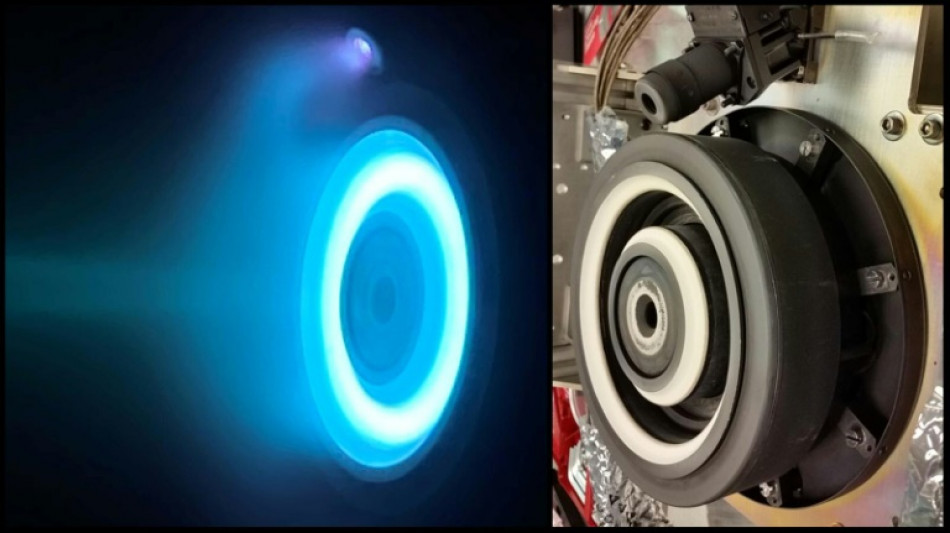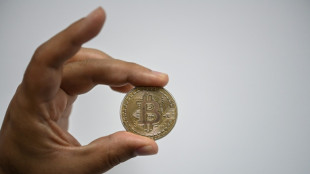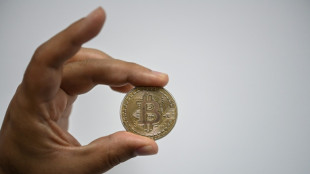
-
 US lawmakers set for explosive vote on Epstein files
US lawmakers set for explosive vote on Epstein files
-
Gianfranco Rosi: the slow documentary maker in a frantic world

-
 P.Priime, Nigeria's young leading Afrobeats producer
P.Priime, Nigeria's young leading Afrobeats producer
-
Merz, Macron to push for European digital 'sovereignty'

-
 Trump hosts Saudi prince for first time since Khashoggi killing
Trump hosts Saudi prince for first time since Khashoggi killing
-
Tonga's Katoa out of NRL season after brain surgery

-
 Japan warns citizens in China over safety amid Taiwan row
Japan warns citizens in China over safety amid Taiwan row
-
In Somalia, a shaky front line barely holds back the 'dogs of war'

-
 Shares in 'Baby Shark' studio jump on market debut
Shares in 'Baby Shark' studio jump on market debut
-
Thunder breeze past Pelicans, Pistons overpower Pacers

-
 Grieving Cowboys remember Kneeland, defeat Raiders
Grieving Cowboys remember Kneeland, defeat Raiders
-
Loaf behind bars: Aussie inmate says Vegemite a human right

-
 In film's second act, 'Wicked' goes beyond Broadway musical
In film's second act, 'Wicked' goes beyond Broadway musical
-
Asian markets track Wall St down with Nvidia, US jobs in view

-
 Scott Boland: the best 'spare' fast bowler around
Scott Boland: the best 'spare' fast bowler around
-
Fire and Ashes: England bank on fast bowling barrage in Australia

-
 North Korea says Seoul-US sub deal will trigger 'nuclear domino' effect
North Korea says Seoul-US sub deal will trigger 'nuclear domino' effect
-
Education for girls hit hard by India's drying wells

-
 Haitian gangs getting rich off murky market for baby eels
Haitian gangs getting rich off murky market for baby eels
-
Trump says will talk to Venezuela's Maduro, 'OK' with US strikes on Mexico

-
 Oscar Piastri wins Australia's top sports honour
Oscar Piastri wins Australia's top sports honour
-
'Severely restricted': Russia's Saint Petersburg faces cultural crackdown

-
 Polish PM denounces 'sabotage' of railway supply line to Ukraine
Polish PM denounces 'sabotage' of railway supply line to Ukraine
-
UK toughens asylum system with radical overhaul

-
 Carney's Liberals pass budget, avoiding snap Canada election
Carney's Liberals pass budget, avoiding snap Canada election
-
LeBron back in training, edges closer to Lakers return

-
 Climate talks run into night as COP30 hosts seek breakthrough
Climate talks run into night as COP30 hosts seek breakthrough
-
Germany and Netherlands lock up World Cup spots in style

-
 Germany's Woltemade hopes for 2026 World Cup spot after scoring again
Germany's Woltemade hopes for 2026 World Cup spot after scoring again
-
Germany 'send message' with Slovakia rout to reach 2026 World Cup

-
 Trump unveils fast-track visas for World Cup ticket holders
Trump unveils fast-track visas for World Cup ticket holders
-
Netherlands qualify for World Cup, Poland in play-offs

-
 Germany crush Slovakia to qualify for 2026 World Cup
Germany crush Slovakia to qualify for 2026 World Cup
-
Stocks gloomy on earnings and tech jitters, US rate worries

-
 'In it to win it': Australia doubles down on climate hosting bid
'In it to win it': Australia doubles down on climate hosting bid
-
Former NFL star Brown could face 30 yrs jail for shooting case: prosecutor

-
 Fate of Canada government hinges on tight budget vote
Fate of Canada government hinges on tight budget vote
-
New research measures how much plastic is lethal for marine life

-
 Mbappe, PSG face off in multi-million lawsuit
Mbappe, PSG face off in multi-million lawsuit
-
EU defends carbon tax as ministers take over COP30 negotiations

-
 McCartney to release silent AI protest song
McCartney to release silent AI protest song
-
Stocks tepid on uncertainty over earnings, tech rally, US rates

-
 Louvre shuts gallery over ceiling safety fears
Louvre shuts gallery over ceiling safety fears
-
'Stranded, stressed' giraffes in Kenya relocated as habitats encroached

-
 US Supreme Court to hear migrant asylum claim case
US Supreme Court to hear migrant asylum claim case
-
Western aid cuts could cause 22.6 million deaths, researchers say

-
 Clarke hails Scotland 'legends' ahead of crunch World Cup qualifier
Clarke hails Scotland 'legends' ahead of crunch World Cup qualifier
-
S.Africa says 'suspicious' flights from Israel show 'agenda to cleanse Palestinians'

-
 South Korea pledges to phase out coal plants at COP30
South Korea pledges to phase out coal plants at COP30
-
Ex-PSG footballer Hamraoui claims 3.5m euros damages against club


Five things to know about NASA's mission to a metal world
For the first time ever, a NASA probe is set to journey to an object composed not of rock, ice, or gas, but metal: the asteroid Psyche.
By studying this space oddity, scientists hope to learn more about the inner cores of rocky planets such as our own -- or, potentially catalog a previously unknown class of cosmic body.
Here are some big numbers and fun facts to dazzle your friends with about the mission.
- $10 quadrillion -
If Psyche were mineable, its iron, nickel and gold deposits could be worth an eye-watering $10,000 quadrillion (that's $10,000,000,000,000,000,000), according to an estimate reported by Forbes magazine.
But Lindy Elkins-Tanton, the mission's principal investigator who was responsible for that calculation, said it's nothing more than a "fun intellectual exercise with no truth to it."
"We have zero technology as a species to bring Psyche back to Earth," she said in a recent briefing. Attempting to do so could backfire by causing an apocalyptic collision -- but even if the endeavor were successful, it would flood the metals market, reducing their value to zero, she said.
- An electric voyage -
The Psyche probe will blast off on a SpaceX Falcon Heavy rocket, but to complete its 2.2 billion-mile (3.6 billion-kilometer) journey, it will turn to a far more efficient form of propulsion.
Psyche's solar arrays convert light into electricity, providing the power for its four solar electric or "Hall-effect" thrusters. These use electromagnetic fields to accelerate and expel ions (charged atoms) of xenon, the same inert gas used in car headlights and plasma TVs.
While the resulting blue glow is evocative of Star Trek, it's no warp drive: the actual force it exerts in a given moment is roughly equal to the weight of an AA battery in the palm of your hand.
But in the void of space, the probe will accelerate continuously to tens of thousands of miles an hour.
- Laser communications -
With deep space missions demanding higher and higher data rates, NASA is turning to laser-based systems to complement radio-frequency based communications.
Psyche will carry onboard a technology experiment, to demonstrate a "10 times augmentation of traditional telecom data rates," said Abi Biswas of NASA's Jet Propulsion Laboratory -- enabling the transmission of higher resolution images, more science data, and streaming video.
NASA will shoot its laser beam from a JPL facility on Table Mountain in California, with the spacecraft firing its signal back to Caltech's Palomar Observatory. The hope is eventually to use the technology on human missions to Mars.
- Gravity science -
Psyche has a suite of dedicated scientific instruments to probe the asteroid's chemical and mineral composition and look for signs of an ancient magnetic field.
But the science team will also use Psyche's trusty old radio system to probe the asteroid's gravity field using the Doppler Effect.
"We can look at the pitch or frequency of the radio waves coming from the antenna and figure out how fast the spacecraft is moving" as it orbits its target, said planetary scientist Ben Weiss, just as ambulance sirens have a higher pitch as they come towards you and lower as they move away.
By tracking the spacecraft's speed at different points around the asteroid, they can determine how "lumpy" the gravity field is, which in turn provides clues about the composition and structure of the interior.
- Less metal, more rock? -
Given its brightness, there was until recently broad consensus that Psyche was almost entirely metal -- consistent with the theory it is an exposed planetary core whose rocky crust and mantle were blown off in an ancient collision.
But the way it imposes gravity on neighboring bodies suggests it's less dense than all iron-body should be, according to a 2022 paper by researchers at Brown University.
One possibility they put forward is iron-spewing volcanoes brought metal up from Psyche's core to coat its surface above a rocky mantle -- effectively creating a structure akin to a metal sandwich.
It won't be until 2029, when the Psyche spacecraft reaches its destination, that we'll know for sure.
N.Shalabi--SF-PST




